-
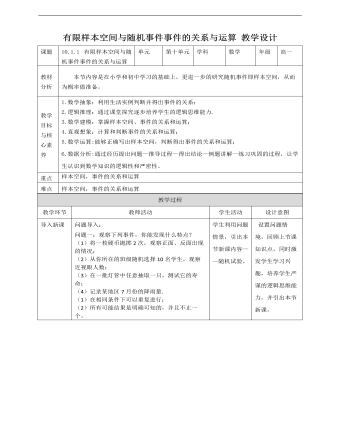
人教A版高中数学必修二有限样本空间与随机事件事件的关系和运算教学设计
新知讲授(一)——随机试验 我们把对随机现象的实现和对它的观察称为随机试验,简称试验,常用字母E表示。我们通常研究以下特点的随机试验:(1)试验可以在相同条件下重复进行;(2)试验的所有可能结果是明确可知的,并且不止一个;(3)每次试验总是恰好出现这些可能结果中的一个,但事先不确定出现哪个结果。新知讲授(二)——样本空间思考一:体育彩票摇奖时,将10个质地和大小完全相同、分别标号0,1,2,...,9的球放入摇奖器中,经过充分搅拌后摇出一个球,观察这个球的号码。这个随机试验共有多少个可能结果?如何表示这些结果?根据球的号码,共有10种可能结果。如果用m表示“摇出的球的号码为m”这一结果,那么所有可能结果可用集合表示{0,1,2,3,4,5,6,7,8,9}.我们把随机试验E的每个可能的基本结果称为样本点,全体样本点的集合称为试验E的样本空间。
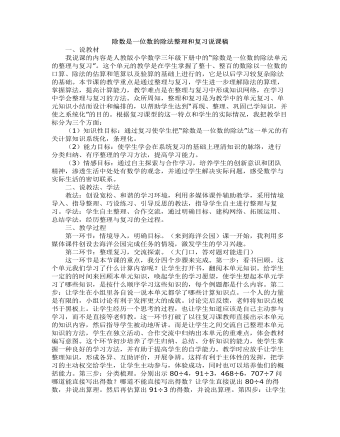
小学数学人教版三年级下册《除数是一位数的除法》整理和复习说课稿
一、说教材我说课的内容是人教版小学数学三年级下册中的“除数是一位数的除法单元的整理与复习”。这个单元的教学是在学生掌握了整十、整百的数除以一位数的口算、除法的估算和笔算以及验算的基础上进行的,它是以后学习较复杂除法的基础。本节课的教学重点是通过整理与复习,学生进一步理解除法的算理,掌握算法,提高计算能力,教学难点是在整理与复习中形成知识网络,在学习中学会整理与复习的方法。众所周知,整理和复习是为教学中的单元复习、单元知识小结而设计和编排的,以帮助学生达到“再现、整理、巩固已学知识,并使之系统化”的目的。根据复习课型的这一特点和学生的实际情况,我把教学目标分为三个方面:(1)知识性目标:通过复习使学生把“除数是一位数的除法”这一单元的有关计算知识系统化,条理化。(2)能力目标:使学生学会在系统复习的基础上理清知识的脉络,进行分类归纳、有序整理的学习方法,提高学习能力。(3)情感目标:通过自主探索与合作学习,培养学生的创新意识和团队精神,渗透生活中处处有数学的观念,并通过学生解决实际问题,感受数学与实际生活的密切联系。
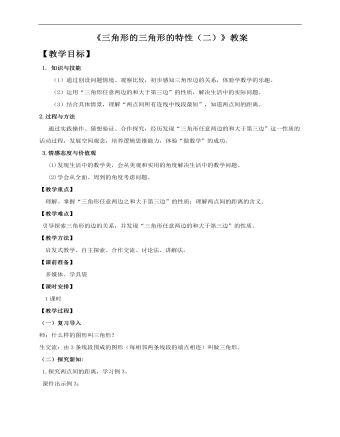
小学数学人教版四年级下册《第2课三角形的特性(二)》教案说课稿
2.过程与方法 通过实践操作、猜想验证、合作探究,经历发现“三角形任意两边的和大于第三边”这一性质的活动过程,发展空间观念,培养逻辑思维能力,体验“做数学”的成功。3.情感态度与价值观 (1)发现生活中的数学美,会从美观和实用的角度解决生活中的数学问题。 (2)学会从全面、周到的角度考虑问题。 【教学重点】 理解、掌握“三角形任意两边之和大于第三边”的性质;理解两点间的距离的含义。【教学难点】 引导探索三角形的边的关系,并发现“三角形任意两边的和大于第三边”的性质。【教学方法】启发式教学、自主探索、合作交流、讨论法、讲解法。【课前准备】多媒体、学具袋【课时安排】 1课时【教学过程】(一)复习导入 师:什么样的图形叫三角形?生交流:由3条线段围成的图形(每相邻两条线段的端点相连)叫做三角形。
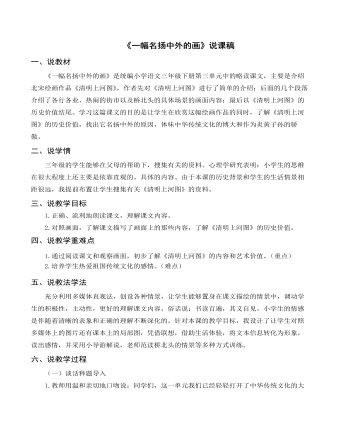
(说课稿)部编人教版三年级下册《一幅名扬中外的画》
一、说教材《一幅名扬中外的画》是统编小学语文三年级下册第三单元中的略读课文,主要是介绍北宋绘画作品《清明上河图》,作者先对《清明上河图》进行了简单的介绍;后面的几个段落介绍了各行各业、热闹的街市以及桥北头的具体场景的画面内容;最后以《清明上河图》的历史价值结尾。学习这篇课文的目的是让学生在欣赏这幅绘画作品的同时,了解《清明上河图》的历史价值,找出它名扬中外的原因,体味中华传统文化的博大和作为炎黄子孙的骄傲。二、说学情三年级的学生能够在父母的帮助下,搜集有关的资料。心理学研究表明:小学生的思维在很大程度上还主要是依靠直观的、具体的内容。由于本课的历史背景和学生的生活情景相距很远,我提前布置让学生搜集有关《清明上河图》的资料。三、说教学目标1.正确、流利地朗读课文,理解课文内容。2.对照画面,了解课文描写了画面上的那些内容,了解《清明上河图》的历史价值。四、说教学重难点1.通过阅读课文和观察画面,初步了解《清明上河图》的内容和艺术价值。(重点)2.培养学生热爱祖国传统文化的感情。(难点)
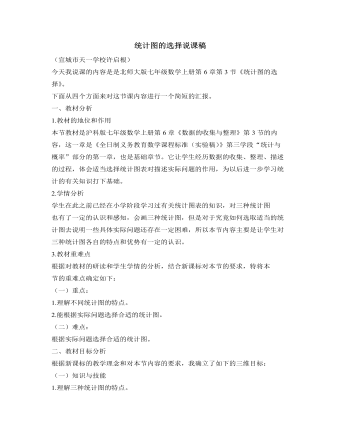
北师大初中数学七年级上册统计图的选择说课稿
四、教学过程分析为有序、有效地进行教学,本节课我主要安排了以下教学环节:(一)复习导入主要复习一下三种统计图,为接下来介绍三种统计图的特点及根据实际问题选取适当的统计图做好知识准备。(二)问题探究选取课本上“小华对1992~2002年同学家中有无电视机及近一年来同学在家看电视的情况”的3个调查项目,进而设计3个探究问题从而加深学生对每一种统计图的进一步认识,至此用自己的语言总结出每一种统计图的特点。(三)实践练兵这一环节通过2个实际问题的设计,通过学生对问题的分析、讨论,使学生认识到适当选取统计图有助于帮助人们去更快速、更准确地获取信息。(四)课堂小结总结这一节课所学的重点知识,这部分主要是让学生自己去总结,看看这节课自己有哪些收获。(五)作业布置进一步巩固本节课所学的知识,达到教学效果。以上就是我对这节课的见解,不足之处还望批评和指正。
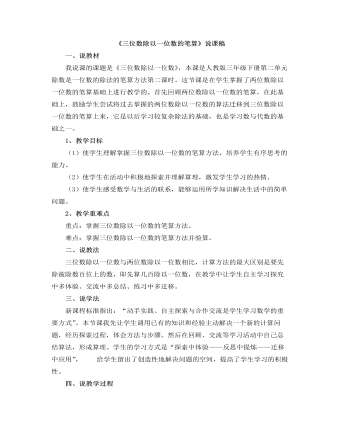
小学数学人教版三年级下册《三位数除以一位数的笔算》说课稿
一、说教材我说课的课题是《三位数除以一位数》,本课是人教版三年级下册第二单元除数是一位数的除法的笔算方法第二课时。这节课是在学生掌握了两位数除以一位数的笔算基础上进行教学的。首先回顾两位数除以一位数的笔算,在此基础上,鼓励学生尝试将过去掌握的两位数除以一位数的算法迁移到三位数除以一位数的笔算上来,它是以后学习较复杂除法的基础,也是学习数与代数的基础之一。1、教学目标(1)使学生理解掌握三位数除以一位数的笔算方法,培养学生有序思考的能力。(2)使学生在活动中积极地探索并理解算理,激发学生学习的热情。 (3)使学生感受数学与生活的联系,能够运用所学知识解决生活中的简单问题。2、教学重难点重点:掌握三位数除以一位数的笔算方法。难点:掌握三位数除以一位数的笔算方法并验算。
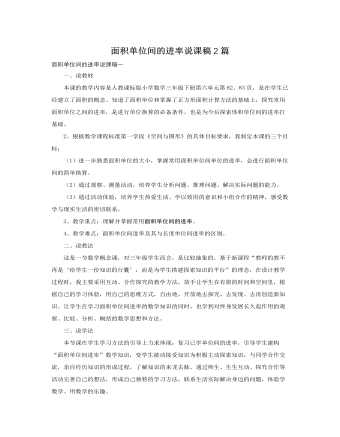
人教版新课标小学数学三年级下册面积单位间的进率说课稿2篇
二、说教材的三维目标和重难点1、知识目标:进一步熟悉面积单位的大小,掌握相邻面积间的进率是100,会进行简单的换算。2、能力目标:培养学生观察、比较、抽象、概括、判断、推理能力及空间观念。3、情感目标:培养学生生生合作的学习精神,乐于助人的集体精神。重点:掌握相邻面积间的进率是100。难点:掌握相邻面积间的进率是100。三、说设计意图对于这节课的教学设计,我们组的教师们尝试从不同的角度去理解教材,先后尝试了多种不同的教学设计,下面仅结合课堂教学中的三大环节(开课、活动操作、练习设计)来简述一下我们的研究过程及我们对每种设计的感受。1、第一环节开课的研究关于开课的研究,第一次试教,学生回忆长度单位复习长度单位间的进率引导到面积单位的研究。
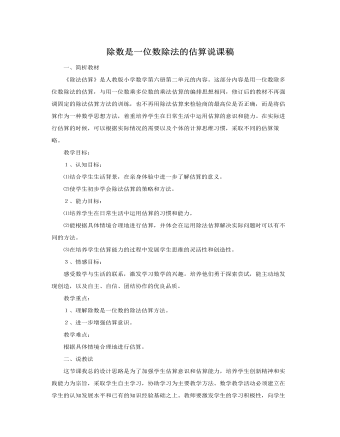
人教版新课标小学数学三年级下册除数是一位数除法的估算说课稿
(让学生观察比较,使他们对估算的作用有了进一步的理解,在说优缺点时让他们比比谁说得更有说服力,使学生在思考时更有动力,调动了他们主动学习的兴趣)小结:估算时只要误差在容许的范围内,估算的方法简便、快速都可以应用。(三)、运用知识解决问题1、做教科书第71页“做一做”中的习题。让不同方法的学生讲一讲自己的思考过程和所用方法的特点。2、解决实际问题。师:“我们年段有362个学生,这星期5个老师要带你们去奶牛场参观,学校租了9辆车,请大家估计一下每辆车上坐多少人?”(让学生用所学的知识解决实际生活问题,激发了学生浓厚的兴趣,让他们主动投入到学习中,并获得成功的体验)五、总结评价让学生说说自己的收获和评价一下这节课自己的或同学的表现。
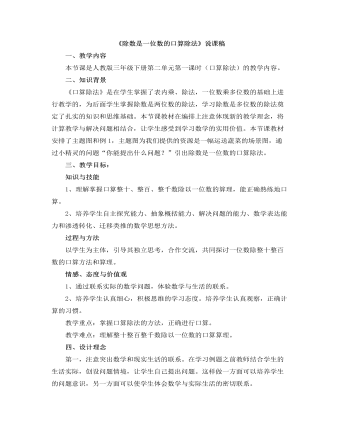
小学数学人教版三年级下册 《除数是一位数的口算除法》说课稿
一、教学内容本节课是人教版三年级下册第二单元第一课时(口算除法)的教学内容。二、知识背景《口算除法》是在学生掌握了表内乘、除法,一位数乘多位数的基础上进行教学的,为后面学生掌握除数是两位数的除法,学习除数是多位数的除法奠定了扎实的知识和思维基础。本节课教材在编排上注意体现新的教学理念,将计算教学与解决问题相结合,让学生感受到学习数学的实用价值。本节课教材安排了主题图和例1,主题图为我们提供的资源是一幅运送蔬菜的场景图,通过小精灵的问题“你能提出什么问题?”引出除数是一位数的口算除法。三、教学目标:知识与技能1、理解掌握口算整十、整百、整千数除以一位数的算理,能正确熟练地口算。2、培养学生自主探究能力、抽象概括能力、解决问题的能力、数学表达能力和渗透转化、迁移类推的数学思想方法。过程与方法以学生为主体,引导其独立思考,合作交流,共同探讨一位数除整十整百数的口算方法和算理。
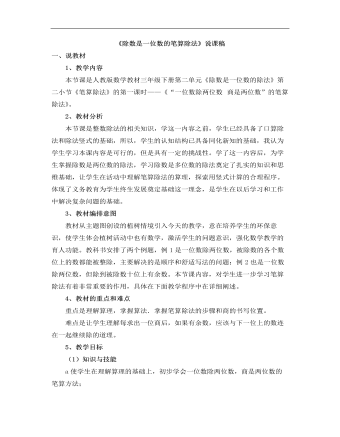
小学数学人教版三年级下册《除数是一位数的笔算除法》说课稿
1、教学内容本节课是人教版数学教材三年级下册第二单元《除数是一位数的除法》第二小节《笔算除法》的第一课时——《“一位数除两位数 商是两位数”的笔算除法》。2、教材分析本节课是整数除法的相关知识,学这一内容之前,学生已经具备了口算除法和除法竖式的基础,所以,学生的认知结构已具备同化新知的基础,我认为学生学习本课内容是可行的,但是具有一定的挑战性。学了这一内容后,为学生掌握除数是两位数的除法,学习除数是多位数的除法奠定了扎实的知识和思维基础,让学生在活动中理解笔算除法的算理,探索用竖式计算的合理程序。体现了义务教育为学生终生发展奠定基础这一理念,是学生在以后学习和工作中解决复杂问题的基础。
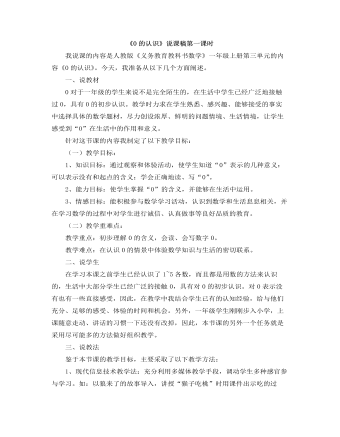
小学数学人教版一年级上册《0的认识》说课稿第一课时
一、说教材 0对于一年级的学生来说不是完全陌生的,在生活中学生已经广泛地接触过0,具有0的初步认识。教学时力求在学生熟悉、感兴趣、能够接受的事实中选择具体的数学题材,尽力创设浓厚、鲜明的问题情境、生活情境,让学生感受到“0”在生活中的作用和意义。针对这节课的内容我制定了以下教学目标: (一)教学目标: 1、知识目标:通过观察和体验活动,使学生知道“0”表示的几种意义:可以表示没有和起点的含义;学会正确地读、写“0”。 2、能力目标:使学生掌握“0”的含义,并能够在生活中运用。 3、情感目标:能积极参与数学学习活动,认识到数学和生活息息相关,并在学习数学的过程中对学生进行诚信、认真做事等良好品质的教育。 (二)教学重难点: 教学重点:初步理解0的含义,会读、会写数字0。 教学难点:在认识0的情景中体验数学知识与生活的密切联系。
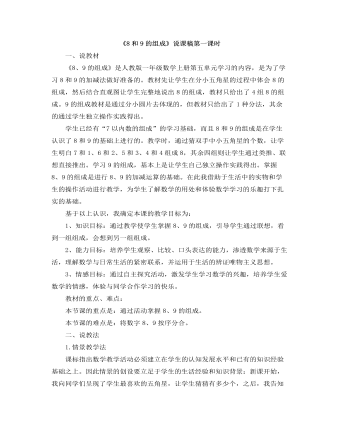
小学数学人教版一年级上册《8和9的组成》说课稿第一课时
一、说教材《8、9的组成》是人教版一年级数学上册第五单元学习的内容,是为了学习8和9的加减法做好准备的。教材先让学生在分小五角星的过程中体会8的组成,然后结合直观图让学生完整地说出8的组成,教材只给出了4组8的组成。9的组成教材是通过分小圆片去体现的,但教材只给出了1种分法,其余的通过学生独立操作实践得出。学生已经有“7以内数的组成”的学习基础,而且8和9的组成是在学生认识了8和9的基础上进行的。教学时,通过猜双手中小五角星的个数,让学生明白7和1、6和2、5和3、4和4组成8,其余四组则让学生通过类推、联想直接推出。学习9的组成,基本上是让学生自己独立操作实践得出。掌握8、9的组成是进行8、9的加减运算的基础。在此我借助于生活中的实物和学生的操作活动进行教学,为学生了解数学的用处和体验数学学习的乐趣打下扎实的基础。
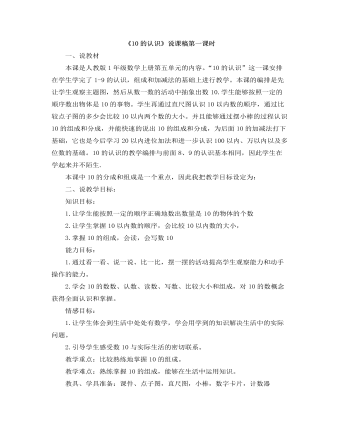
小学数学人教版一年级上册《10的认识》说课稿第一课时
一、说教材本课是人教版1年级数学上册第五单元的内容。“10的认识”这一课安排在学生学完了1-9的认识,组成和加减法的基础上进行教学。本课的编排是先让学生观察主题图,然后从数一数的活动中抽象出数10.学生能够按照一定的顺序数出物体是10的事物。学生再通过直尺图认识10以内数的顺序,通过比较点子图的多少会比较10以内两个数的大小。并且能够通过摆小棒的过程认识10的组成和分成,并能快速的说出10的组成和分成,为后面10的加减法打下基础,它也是今后学习20以内进位加法和进一步认识100以内、万以内以及多位数的基础。10的认识的教学编排与前面8、9的认识基本相同,因此学生在学起来并不陌生.本课中10的分成和组成是一个重点,因此我把教学目标设定为:
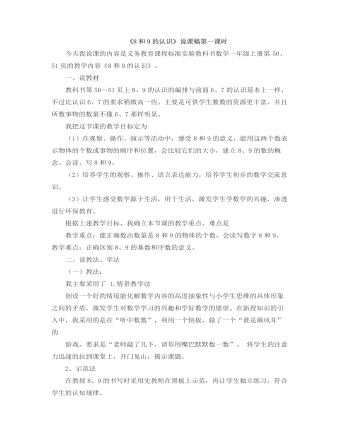
小学数学人教版一年级上册《8和9的认识》说课稿第一课时
今天我说课的内容是义务教育课程标准实验教科书数学一年级上册第50、51页的教学内容《8和9的认识》。一、说教材教科书第50~51页上8、9的认识的编排与前面6、7的认识基本上一样,不过比认识6、7的要求稍微高一些。主要是可供学生数数的资源更丰富,并且所数事物的数量不像6、7那样明显。我把这节课的教学目标定为(1)在观察、操作、演示等活动中,感受8和9的意义,能用这两个数表示物体的个数或事物的顺序和位置,会比较它们的大小,建立8、9的数的概念。会读、写8和9。(2)培养学生的观察、操作、语言表达能力,培养学生初步的数学交流意识。(3)让学生感受数学源于生活,用于生活,激发学生学数学的兴趣,渗透进行环保教育。根据上述教学目标,我确立本节课的教学重点、难点是教学重点:能正确数出数量是8和9的物体的个数,会读写数字8和9。 教学难点:正确区别8、9的基数和序数的意义。
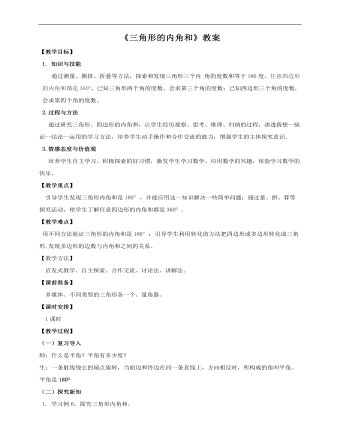
小学数学人教版四年级下册《第四课三角形的内角和》教案说课稿
2.过程与方法 通过研究三角形、四边形的内角和,让学生经历观察、思考、推理、归纳的过程,渗透猜想--验证--结论--运用的学习方法,培养学生动手操作和合作交流的能力,增强学生的主体探究意识。3.情感态度与价值观 培养学生自主学习、积极探索的好习惯,激发学生学习数学、应用数学的兴趣,体验学习数学的快乐。【教学重点】 引导学生发现三角形内角和是180°,并能应用这一知识解决一些简单问题;通过量、拼、算等探究活动,使学生了解任意四边形的内角和都是3600 。【教学难点】 用不同方法验证三角形的内角和是180°;引导学生利用转化的方法把四边形或多边形转化成三角形,发现多边形的边数与内角和之间的关系。【教学方法】启发式教学、自主探索、合作交流、讨论法、讲解法。【课前准备】多媒体、不同类型的三角形各一个、量角器。
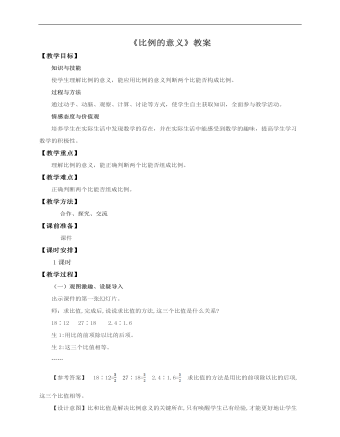
小学数学人教版六年级下册《第一课比例的意义》教案说课稿
(一)观图激趣、设疑导入 出示课件的第一张幻灯片。师:求比值,完成后,说说求比值的方法,这三个比值是什么关系?18∶12 27∶18 2.4∶1.6生1:用比的前项除以比的后项。生2:这三个比值相等。……【参考答案】 18∶12= 27∶18= 2.4∶1.6= 求比值的方法是用比的前项除以比的后项,这三个比值相等。【设计意图】比和比值是解决比例意义的关键所在,只有唤醒学生已有经验,才能更好地让学生投入到学习比例意义活动中来,为实现教学目标做好铺垫。(二)探究新知师:同学们,每周一的早上我们学校都要举行庄严的升国旗仪式,那么,你们对国旗都有哪些了解呢? 生1:我们的国旗是红色的,上面有五颗黄色的五角星。生2:我们的国旗是长方形的。师:同学们回答得真好,说出了自己对国旗的了解,可以看出同学们对我们国家的热爱,老师希望你们一定要好好学习,为我们的五星红旗增光!五星红旗是庄严而美丽的, 并且它与我们数学也有着密切的联系,这也就是我们今天所要研究的内容——比例。(板书课题:比例的意义)国旗长5米,宽米。国旗长2.4米,宽1.6米。国旗长60厘米,宽40厘米。
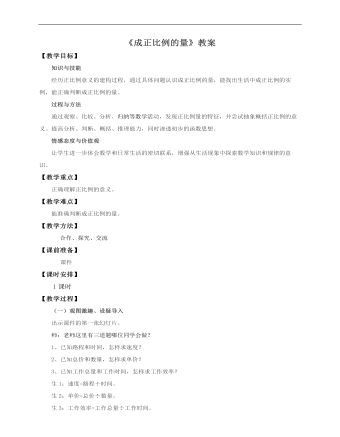
小学数学人教版六年级下册《第一课成正比例的量》教案说课稿
(一)观图激趣、设疑导入 出示课件的第一张幻灯片。师:老师这里有三道题哪位同学会做?1、已知路程和时间,怎样求速度?2、已知总价和数量,怎样求单价?3、已知工作总量和工作时间,怎样求工作效率?生1:速度=路程÷时间。生2:单价=总价÷数量。生3:工作效率=工作总量÷工作时间。师:同学们可真棒!这节课我们就来研究这些数量间的一些规律和特征。你们准备好了吗?生:准备好了!(板书:成正比例的量)【设计意图】引发学生学习的兴趣,唤起学生已有的只是经验,更好地进行新旧知识的结合,也有利于引导学生发现数量关系内在的规律。(二)探究新知(PPT课件出示例1)文具店有一种铅笔,销售的数量与总价的关系如下表。 数量/支12345678…总价/元3.5710.51417.52124.528…观察上表,回答下面的问题。(1)表中有哪两种量?(2)总价是怎样随着数量的变化而变化的?(3)相应的总价与数量的比分别是多少?比值是多少?1.探究数量与总价两个量之间的关系。师:仔细观察这张表格,它为我们提供了哪些数学信息?生:给我们提供了文具店销售彩带的数量是1,2,3,4,5,6,7,8米,总价分别是:3.5, 7,10.5,14,17.5,21,24.5,28元。师:表中有哪两种量?生:有数量和总价两种量。师:总价是怎样随着数量的变化而变化的?生:总价是随数量的增加而增加的。师:相应的总价与数量的比分别是多少?比值是多少?生1:=3.5 =3.5 =3.5 =3.5 =3.5 =3.5 =3.5 =3.5生2:相对应的总价和数量的比的比值是一定的。师:总价与数量的比值表示什么?
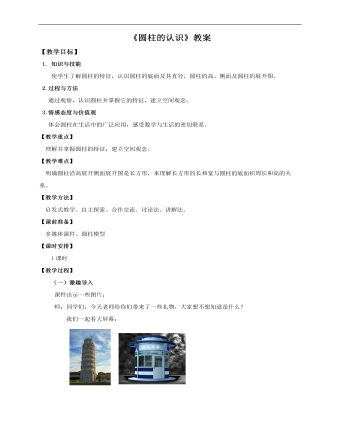
小学数学人教版六年级下册《第一课圆柱的认识》教案说课稿
(一)激趣导入 课件出示一些图片:师:同学们,今天老师给你们带来了一些礼物,大家想不想知道是什么?我们一起看大屏幕:你们认识这些物体吗?在生活中见到过吗?生:比萨斜塔、治安岗亭、茶叶盒、客家围屋。师:今天这节课我们重点来研究这些物体。(二)探究新知 1. 认识圆柱。师:这些物体什么形状的?它们的形状有什么共同特点?生:这些物体都是圆柱形的。师小结:这些物体的形状都是圆柱体,简称圆柱。说一说生活中有哪些圆柱形的物体。2.探究圆柱的特特征。(1)认识底面小组活动: 观察圆柱形物体,看看它是有几部分组成的,有什么特征?课件演示:圆柱的上、下两个面叫做底面,是两个完全相同的圆。 师:请同学们量一量、算一算圆柱的两个底面有什么关系?生1:两个底面的直径相等、半径相等。生2:两个底面的周长相等、面积相等。师小结:圆柱的底面是两个完全相同的圆。(2)认识侧面课件演示:圆柱周围的面叫做侧面,侧面是一个曲面。师:请同学们指一指圆柱的侧面,再用手摸一摸,有什么感觉?生:侧面是弯曲的。师:侧面是一个曲面。
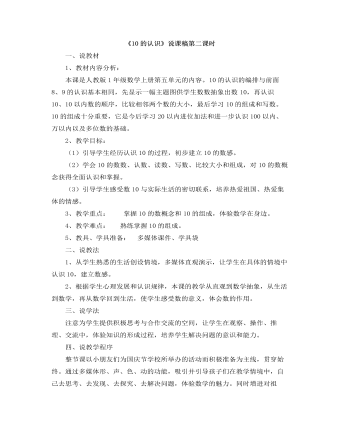
小学数学人教版一年级上册《10的认识》说课稿第二课时
一、说教材1、教材内容分析:本课是人教版1年级数学上册第五单元的内容。10的认识的编排与前面8、9的认识基本相同,先显示一幅主题图供学生数数抽象出数10,再认识10、10以内数的顺序,比较相邻两个数的大小,最后学习10的组成和写数。10的组成十分重要,它是今后学习20以内进位加法和进一步认识100以内、万以内以及多位数的基础。 2、教学目标: (1)引导学生经历认识10的过程,初步建立10的数感。 (2)学会10的数数、认数、读数、写数、比较大小和组成,对10的数概念获得全面认识和掌握。 (3)引导学生感受数10与实际生活的密切联系,培养热爱祖国、热爱集体的情感。 3、教学重点: 掌握10的数概念和10的组成,体验数学在身边。 4、教学难点: 熟练掌握10的组成。 5、教具、学具准备: 多媒体课件、学具袋
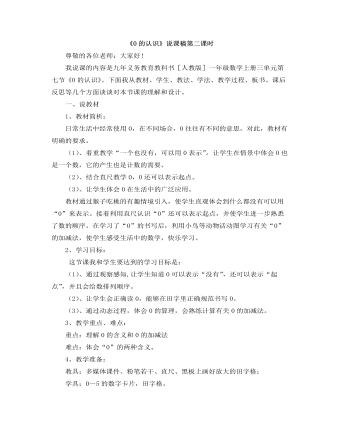
小学数学人教版一年级上册《0的认识》说课稿第二课时
尊敬的各位老师:大家好!我说课的内容是九年义务教育教科书[人教版]一年级数学上册三单元第七节《0的认识》。下面我从教材、学生、教法、学法、教学过程、板书、课后反思等几个方面谈谈对本节课的理解和设计。 一、说教材 1、教材简析: 日常生活中经常使用0,在不同场合,0往往有不同的意思。对此,教材有明确的要求。 (1)、着重教学“一个也没有,可以用0表示”。让学生在情景中体会0也是一个数,它的产生也是计数的需要。 (2)、结合直尺教学0,0还可以表示起点。 (3)、让学生体会0在生活中的广泛应用。 教材通过猴子吃桃的有趣情境引入,使学生直观体会到什么都没有可以用“0”来表示。接着利用直尺认识“0”还可以表示起点,并使学生进一步熟悉了数的顺序。在学习了“0”的书写后,利用小鸟等动物活动图学习有关“0”的加减法,使学生感受生活中的数学,快乐学习。 2、学习目标: 这节课我和学生要达到的学习目标是: (1)、通过观察感知,让学生知道0可以表示“没有”,还可以表示“起点”,并且会给数排列顺序。

